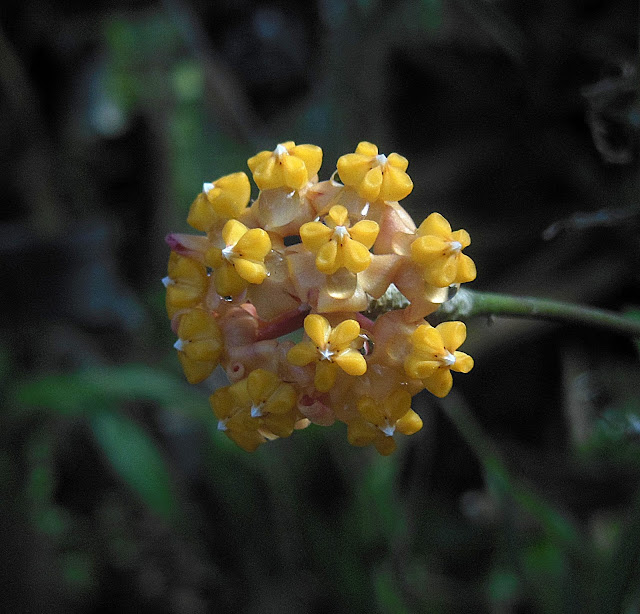The petite Hoya myrmecopa
 |
| Hoya myrmecopa |
Hoya myrmecopa was originally described in 2001 from specimens collected from near Tentena in Sulawesi. And by the latter part of the last decade, plants were detected from the province of Quezon on Luzon, and was early on circulated as Hoya sp. Sulawesi. Not long after, it was determined that H. myrmecopa isn't endemic to Sulawesi after all, but the range extension is enormous. In 2013, Philippine plants were assigned to subspecies kapatalanensis (Kloppenburg, Siar, Cajano, Guevarra & Carandang, 2013) in the very badly edited Hoya New (the protologue was also very badly written), and differentiated from the supposedly nominate subspecies by the longer peduncles and over-all larger habit of the plants; note that despite being found first in the province of Quezon, the authors opted to give the name after Kapatalan, a barangay in the town of Siniloan in the province of Laguna (only goes to show that species names ending in -ensis/-ense can suck big time because these can often be ambiguous, apart from being unimaginative- but that's just me). I do not, however, subscribe to the idea that Philippine plants are distinct, although the gods in the hallowed halls of Kew buys it. While it seems true that Philippine plants appear to be larger in all aspects (and thus horticulturally more attractive than the Sulawesi ones), what often happens with widely distributed species is that different populations tend to develop differently from one another, particularly with regards to dimensions, and that is often due to environmental pressures. Describing a variety, subspecies, or even a species from very minor differences sets a precedent that everything that looks slightly different is ought to be described as new. Variation is inherent within all species. Just look at the human race to see what I mean.
And so, Philippine plants should only be called Hoya myrmecopa. Period.
 |
| Photo illustrates the elongated peduncle inherent in Philippine populations of this species. |
Hoya myrmecopa is more of a root climbing epiphyte rather than twining, as is the case with most Hoya species, and is not as rampant of a grower. I have two pots of this species at home, and both have shown contentment being in their respective containers, with one of the two just rooting and creeping around its own pot instead of invading the spaces of its neighboring plants. For collectors with small growing spaces to spare, this is a Hoya to consider. The leaves are thickly succulent, but this species cannot withstand long periods of drought. In its native habitats, rains, drizzles, and dew are very frequent along with a distinct lowering of temperatures at night. Keeping this species in a continuously very warm environment and not giving enough water can prove detrimental in the long run. But when conditions are to its liking, Hoya myrmecopa is an easy plant to maintain, and will produce flowers quite often even with minimal care. Its light requirements are moderate, but when cultivated under strong light then watering has to step up to compensate for the plants' transpiration. Under more harsh lighting, the leaves take on a reddish tinge due to production of anthocyanin pigments. Conversely, plants kept under shadier conditions develop larger leaves of a thinner texture.
 |
| The corolla lobes of H. myrmecopa are revolute, which supports the blocky coronas. |
At this point I would like to draw attention to the choice of the species name myrmecopa. The species name translates to 'ant hole' and refers to the first specimen's habitus of growing in a hole in a tree that is populated with ants, with the ants providing the nutrients that the plants utilize for its use. The association with ants is an indication that this species favor acidic substrates; ants naturally produce formic acid, which is a known anti-bacterial. Thus, H. myrmecopa qualifies as an ant plant, although facultatively. In cultivation, these plants are rarely colonized by ants and will grow fine even without them, for as long as a fertilizing regime is being observed.
To close, H. myrmecopa is an interesting species to include in a tropical plant collection- manageably small, adaptable, easy to care for, and free blooming. The challenge is finding one for your growing space.
Update:
The flowers of H. myrmecopa does not really attract pollinators on the first day of anthesis, but on the second, when the flowers start producing copious amounts of nectar:
 |



what a nicely written article, and that first picture is very beautiful. I have not seen discussions about H myrmecopa and yours is great, also smiled at the Hoya New description.
ReplyDeleteThis comment has been removed by the author.
ReplyDeleteThis comment has been removed by the author.
ReplyDelete